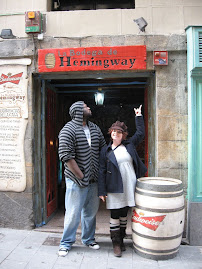Just some thoughts I've started getting together--it's pretty vague and sketchy still:
Since the DSM-IV first defined autism and autism spectrum disorders as pervasive developmental disorders separate from schizophrenia and childhood emotional disturbances in 1990, scholars in medicine, biology, chemistry, genetics, psychiatry, psychology, education, and environmental science have published thousands of books, journal articles, and research studies in an attempt to better understand this neurological condition. A simple search in any medical database at any university library on "autism" will pull up tens of thousands of entries.
However, a search on the "representation" of autism in the Humanities will yield only a handful of books and journal articles; in fact, many notable works in Disability Studies do not even mention autism. Discussions on mental illness often focus primarily on schizophrenia and bi-polar disorder. For instance, in Lauri E. Klobas' book Disability Drama in Television and Film, she cites thousands of instances when mentally and physically disabled characters have appeared in Western television programs and films; however, she does not cite one movie or television program with an autistic character, although autistic characters have appeared in more than fifty-five feature films and made-for-television movies, as noted by Stuart Murray in his article "Hollywood and the Fascination with Autism." Likewise, recent publications by James C. Wilson and Cynthia Lewinsky-Wilson (Embodied Rhetorics: Disability in Language and Culture (2001)) and Sharon L. Snyder and Brenda Jo Bruggemann (Disability Studies: Enabling the Humanities (2002)) do not even mention, much less discuss, the rhetoric or representation of autism.
While the recent media and public attention on autism have increased awareness and interest in this neurological condition, scholars in the Humanities have yet to discuss this matter as extensively as scholars in medicine and education have. More recently, two notable works on the construction of autism in Western discourses by Majia Nadesan (Constructing Autism (2005)) and Roy Grinker (Unstrange Minds (2007)) have been published; however, neither works examine the rhetoric of the representation and identification of autism, particularly in Western media.
While the recent media and public attention on autism have increased awareness and interest in this neurological condition, scholars in the Humanities have yet to discuss this matter as extensively as scholars in medicine and education have. Therefore, my dissertation will examine the rhetoric of agency and identification of autism spectrum disorders as reflected in Western media, including films with autistic characters or characters who exhibit autistic behaviors, youtube videos, and autism-related blogs. Through films, online videos, and online journals, autistic individuals and parents of autistic children are able to share their experiences with various treatments and news publications. [This part needs alot of work. Need to be much more specific.]
Little doubt exists as to the influence of films and television on our perceptions of society; our "visual culture" shapes both how we act toward each other and how we respond to those actions. The perceptions of the physically and mentally disabled are significantly relevant since such perceptions in turn shape how society, as a whole, treats, responds to, and cares for those who are primarily considered "inferior," "broken," or an "other" in society. Likewise, new media online video servers, such as youtube, and online journals allow autistic individuals and parents of autistic children to share their experiences with various treatments and their responses to and concerns regarding news publications. Therefore, my dissertation will examine the representation of autism spectrum disorders in Western media--films, television programming, youtube, and online journals--in order to illustrate how Western media both reflects society's anxieties regarding developmental (and invisible) disabilities and how those anxieties manifest in Western diagnosis, treatment, and care for individual with autism spectrum disorders.
As W. J. T. Messaris notes in his book Picture Theory, the importance and reliance on the visual has led to the current "pictorial turn"--a turn in which humans rely on images, rather than the text, to understand the world around them. This "pictorial turn" is no less important in regard to media and disability studies. The ways in which the disabled are "gazed" upon by the camera and online reflects non-disabled anxieties and concerns regarding the disabled--both of which shape how the non-disabled and the disabled, themselves, respond to those with disabilities when they are no longer visually represented in the media. Still, this concern for "visual culture" is particularly relevant in regard to disability studies because "visualizing" is often a passive activity--images flood us in all facets of our lives and we, in turn, "receive" them. We use those images to understand and construct the world around us. Humans, in turn, use what those images to as a means of signification--to identify, define, categorize, and interpret the world around us. Images allow humans to identify what an object is in respect to what it is not; in other words, images of the color "red" enable viewers to distinguish it from the color "blue." Likewise, humans use images to categorize what is "normal" from "abnormal"--wearing tennis shoes on our feet is "normal" while wearing them on our hands is "abnormal."
However, the ability of images in our visual culture to distinguish what is considered "normal" from "abnormal" has profound consequences when applied to the human body. Images of "health" and "vitality" become synonymous with "normal" while images of "difference" and "disfigurement" become analogous with "abnormality." Consequently, the "abnormal" body is separated, distinguished, and isolated as something to fear, loathe, and pity. As such, the disabled have throughout history been marginalized because of their perceived "differences." The ever-popular circus freak show in the nineteenth century illustrates the pervasiveness of the human interest in those whose bodies and minds render them "abnormal." During the twentieth century, the "freak show" moved out of the circus tent and into television programs and feature films. Audiences have been fascinated with the gruesomeness of the "monster" in Frankenstein, the deformed Hunchback of Notre Dame, and the remarkable "genius" of Rain Man. The marginalized "others" often serve as educational fodder for cable television, as seen on such programs as Medical Incredible on TLC (The Learning Channel) and the weekly specials often featured on The Discovery Health Channel. Such programs as "The Mermaid Girl," "The Boy Whose Skin Fell Off," and "400 Pound Tumor" have resurrected the circus freak show under the auspices of "education," "health," and "learning."
While those with visible disabilities are often "gazed" upon as "abnormal," those with invisible disabilities pose different concerns; namely, how do we "gaze" upon someone whose "abnormality" is invisible to the naked eye? What complexities exist for the disabled with their "abnormalities" or "differences" are not visible in this increasingly visual culture? Additionally, how does the visually-dependent media (specifically, the medium of television, film, and the internet) construct the images of those with invisible disabilities when their disabilities are not visible? The visualization and marginalization of those with invisible disabilities, especially autism, are represented and reinforced in Western media and in turn shape how those with invisible disabilities are treated (and not treated) by society. As such, these issues are just a few of the concerns I will address in my dissertation.
[After reading these last 4 paragraphs, I wonder if a major "section" (chapters?) of my dissertation will involve the "gaze" of autism. Particularly who is gazing? How does the "gaze" of those with autism, perhaps as reflected in Send in the Idiots, Mozart and the Whale, Born on a Blue Day, and other autism narratives, differ from the gaze of observers--parent's narratives, television, film, blogs? This conversation could include discussions on disclosure, particularly relevant for online electronic communities in blogs and online discussion groups.
I keep seeing two main discussions in my readings--identification and agency. Perhaps the meta-terms that connect the dissertation as a whole together? Then, I think looking at the "gaze" of autism would connect well within the larger discussion of identification and agency. Or, maybe not...]








No comments:
Post a Comment